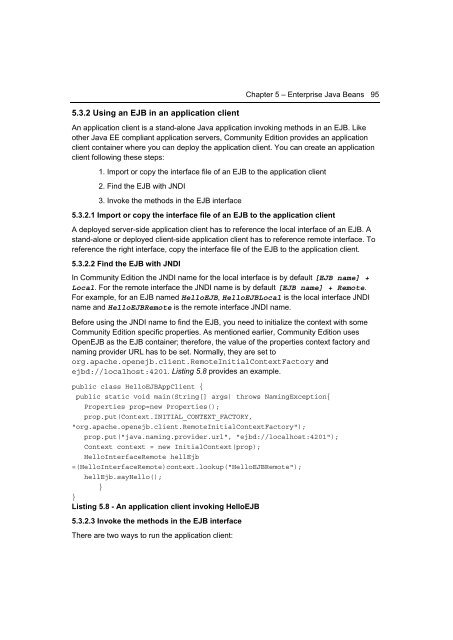Getting Started with WebSphere Application Server
You also want an ePaper? Increase the reach of your titles
YUMPU automatically turns print PDFs into web optimized ePapers that Google loves.
Chapter 5 – Enterprise Java Beans 95<br />
5.3.2 Using an EJB in an application client<br />
An application client is a stand-alone Java application invoking methods in an EJB. Like<br />
other Java EE compliant application servers, Community Edition provides an application<br />
client container where you can deploy the application client. You can create an application<br />
client following these steps:<br />
1. Import or copy the interface file of an EJB to the application client<br />
2. Find the EJB <strong>with</strong> JNDI<br />
3. Invoke the methods in the EJB interface<br />
5.3.2.1 Import or copy the interface file of an EJB to the application client<br />
A deployed server-side application client has to reference the local interface of an EJB. A<br />
stand-alone or deployed client-side application client has to reference remote interface. To<br />
reference the right interface, copy the interface file of the EJB to the application client.<br />
5.3.2.2 Find the EJB <strong>with</strong> JNDI<br />
In Community Edition the JNDI name for the local interface is by default [EJB name] +<br />
Local. For the remote interface the JNDI name is by default [EJB name] + Remote.<br />
For example, for an EJB named HelloEJB, HelloEJBLocal is the local interface JNDI<br />
name and HelloEJBRemote is the remote interface JNDI name.<br />
Before using the JNDI name to find the EJB, you need to initialize the context <strong>with</strong> some<br />
Community Edition specific properties. As mentioned earlier, Community Edition uses<br />
OpenEJB as the EJB container; therefore, the value of the properties context factory and<br />
naming provider URL has to be set. Normally, they are set to<br />
org.apache.openejb.client.RemoteInitialContextFactory and<br />
ejbd://localhost:4201. Listing 5.8 provides an example.<br />
public class HelloEJBAppClient {<br />
public static void main(String[] args) throws NamingException{<br />
Properties prop=new Properties();<br />
prop.put(Context.INITIAL_CONTEXT_FACTORY,<br />
"org.apache.openejb.client.RemoteInitialContextFactory");<br />
prop.put("java.naming.provider.url", "ejbd://localhost:4201");<br />
Context context = new InitialContext(prop);<br />
HelloInterfaceRemote hellEjb<br />
=(HelloInterfaceRemote)context.lookup("HelloEJBRemote");<br />
hellEjb.sayHello();<br />
}<br />
}<br />
Listing 5.8 - An application client invoking HelloEJB<br />
5.3.2.3 Invoke the methods in the EJB interface<br />
There are two ways to run the application client:

















